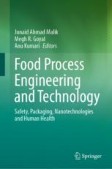Search
Search Results
-
Neuraminidase Inhibitory Activities of Some Alcoholic Plant Extracts and Chemical Compounds
AbstractIn today’s world, disease rates are increasing day after day because of environmental factors, lifestyles and technology. Although there are...

-
Application and evaluation of plant-based edible active coatings to enhance the shelf-life and quality attributes of Jara lebu (Citrus medica)
Edible coatings for fruits and vegetables are the subject of intensive agro-based research. These coatings provide value to the product due to their...

-
Recent Trends in Edible Packaging for Food Applications — Perspective for the Future
Edible packaging plays an important role in protecting food products from physical, mechanical, chemical, and microbiological damages by creating a...

-
Plant Antioxidants and Antimicrobials in Edible and Non-edible Active Packaging Films
Smart packaging, including active packaging and edible packaging materials, are novel packaging systems, which may lead in enhanced quality and...
-
Characterization of chitosan edible coatings made with natural extracts of Solanum lycopersicum and Moringa oleifera for preserving fresh pork tenderloin
The purpose of this study was to develop edible films based on chitosan that also incorporate natural extracts of tomato (T) and moringa (M). The...

-
Edible fruit extracts and fruit juices as potential source of antiviral agents: a review
Fruits have been widely consumed since the beginning of human evolution and are important source of a healthy being and helpful in treating various...

-
Nanochitosan augmented with essential oils and extracts as an edible antimicrobial coating for the shelf life extension of fresh produce: a review
With increasing population and growing demands for ‘ready-to-consume’ high-quality fresh produce with longer shelf life, development of smart and...

-
Quantifying the potential renal acid load of edible mushrooms
The capability of any food to alter net endogenous acid or base production can be estimated using the potential renal acid load (PRAL) estimation...

-
Emergence of cheese packaging by edible coatings for enhancing its shelf-life
Cheese is one of the most popular and extensively consumed dairy products. It comes in a variety of flavors, textures, shapes and is prone to...

-
Investigation of biological activity of Alpinia platychilus extracts and its use as a natural preservative in fruits
This study was conducted to explore Alpinia platyjchilus extract as plant source preservative instead of chemical preservative. Finding a plant-based...

-
Applications of Edible Coatings to Extend Shelf-life of Fresh Fruits
Bioagents, fast respiration and degradation contribute to short shelf-life of fresh fruits. Water quality degrades soon after harvest because of...
-
The Edible Plant Crithmum maritimum Shows Nutraceutical Properties by Targeting Energy Metabolism in Hepatic Cancer
In the past few years, evidence has supported the role of plants as a valuable tool for the development of promising therapeutic support options for...

-
Antimicrobial Edible Films for Food Preservation: Recent Advances and Future Trends
Food packaging is an essential line to defend against the intrusion of undesirable external factors to protect food. The antibacterial edible films...

-
Characteristics of edible jelly enriched with antioxidant and calcium-rich fractions of dandelion leaf polysaccharide extracts
To improve the healthiness appeal of edible jelly, water-soluble extract (DP 1 ) and polysaccharides (DP 2 ) fractions obtained from dandelion (Taraxacum...

-
Applicability of edible Candelilla wax composite blended with Bryophyllumpinnatum extract to prolong shelf life of fruits/vegetables
Candelilla wax (CW) is a natural lipid source that can be used to make biodegradable and edible coatings and films for fruits. However, CW alone does...

-
An overview on smart and active edible coatings: safety and regulations
Edible coatings involves implementation of natural and active ingredients on food surfaces in the form of thin layers either as solid or liquid...

-
Bioactive compounds, nanoparticles synthesis, health benefits and potential utilization of edible flowers for the development of functional dairy products: a review
The food sector faces difficulty meeting the expectations for high-quality food items with safe and clean perceptions in light of customers’...

-
Edible Insects, a Sustainable Alternative for Human Feeding and Food Processing
The Food and Agriculture Organization of the United Nations (FAO/UN) estimates that the world’s population will exceed 9.1 billion people by 2050....
-
Effect of edible coatings on quality parameters and phenol composition of ready-to-eat Salanova lettuce
Minimally processed fresh-cut leafy vegetables are becoming one of the fastest growing segments in the food industry. In this context, new strategies...

-
Antiradical, pH and ammonia sensitive properties of Aronia melanocarpa L. and Beta vulgaris L. aqueous extracts
Plant extracts have received much attention according to the wide area of potential applications. In recent years, pH-sensitive colorimetric...

